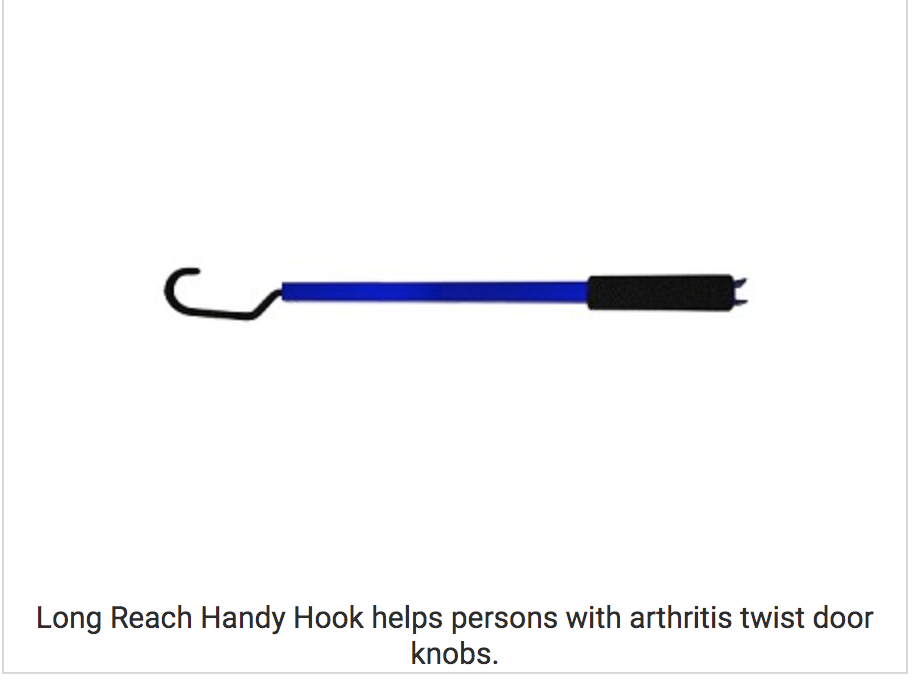
While I was looking into designs meant to help people with disabilities, I saw a few images of door handle adapters. I was very aware of the problem round doorknobs can pose since my parents always made a comment when a doorknob wasn’t ADA approved (honestly, I have no clue why they did this they both have fully functioning hands). I hadn’t ever considered that these doorknobs could be adapted, I just thought they should all be replaced with the handle style so that they were easier for people with limited mobility. The adapters I saw ranged in design success but almost all of them seemed to be trying to fix the problem, not the person. If a place can’t for some reason replace their doorknobs with the handle style (which would be cheaper than buying one of these adapters so I don’t know why) then this is the least they could do. I think that it satisfies the need of having a door handle that is easier to grip/move and just generally makes it easier to open. This style is good for anyone who finds it easier to pull down than to grab and twist, or even someone using a tool to open things. The image I included at the top was the best design that I saw because it allows for that downward pulling motion. Now let’s look at some worse ones.

Image of EZ Door Knob Grip sold at Home Depot 
Woman using the EZ Door Knob Grip
I think this EZ Door Knob Grip sold at Home Depot is about a 2/5 stars for accessibility. It would hypothetically make the knob grippier and provide some leverage but it still would require a hand to make a grabbing and twisting motion. The image that they included shows someone opening it with their elbow which I cannot figure out how successful that would be. I can’t imagine it working well. This design leaves out anyone using a tool or aide that might have a hooked shape because the grips on it are small and flat.

Image of Long Reach Handy Hook 
Long Reach Handy Hook opening a door
The Long Reach Handy Hook sold on www.arthritissupplies.com confuses me. It says it’s good for people in wheelchairs because it allows you to open a door out of its swing path, which I think might be its only redeeming function. It definitely feels like it’s trying to fix the person though. The description says, “The non-slip hook is placed underneath the doorknob, letting it freely rest. The user then holds the cushion grip and simply turns the handle to open the doorknob. The other end has a special tool designed for unlocking deadbolts and twist locks. The long handle and non-slip grip hook increases torque for the user to easily turn the doorknob or lock.” And the image shows it opening a round-knobed door. But I have no clue how that would work plus it requires someone to be able to hold onto a pole AND carry it around with them. The single reviewer of the item on the website had the same doubts:

It sounds like from this review that it maybe can open this style of doors? But they also mentioned that the things they needed it for still required a “bit of effort” and that it scratched their car door so I don’t think that any disable people were consulted when designing this product. 1/5 stars from me.
I am specifically addressing ways to improve round doorknobs so I didn’t necessarily see any other designs despite a few variations on the first one. I think that, should someone want to make their round doorknobs more accessible but refuse to replace them, that style of adapter would probably be the best from the current choices on the market. I don’t know if I’m missing something but I have no clue why someone would choose a round doorknob at this point, why not just choose the more accessible option? I have round doorknobs in my house right now after growing up with the handle style and every time my hands are full I curse those round doorknobs. Accessible ones just make life easier for everyone, as many accessible products do. As the ADA guidelines say, “Door hardware that can be operated with a closed fist or a loose grip accommodates the greatest range of users.“

Operable parts shall be operable with one hand and shall not require tight grasping, pinching, or twisting of the wrist. Most lever-operated mechanisms, push-type mechanisms, and U-shaped handles are acceptable designs. The force required to activate operable parts shall be 5 pounds (22.2 N) maximum.
Door hardware that can be operated with a closed fist or a loose grip accommodates the greatest range of users. Hardware that requires simultaneous hand and finger movements require greater dexterity and coordination, and is not recommended.”
